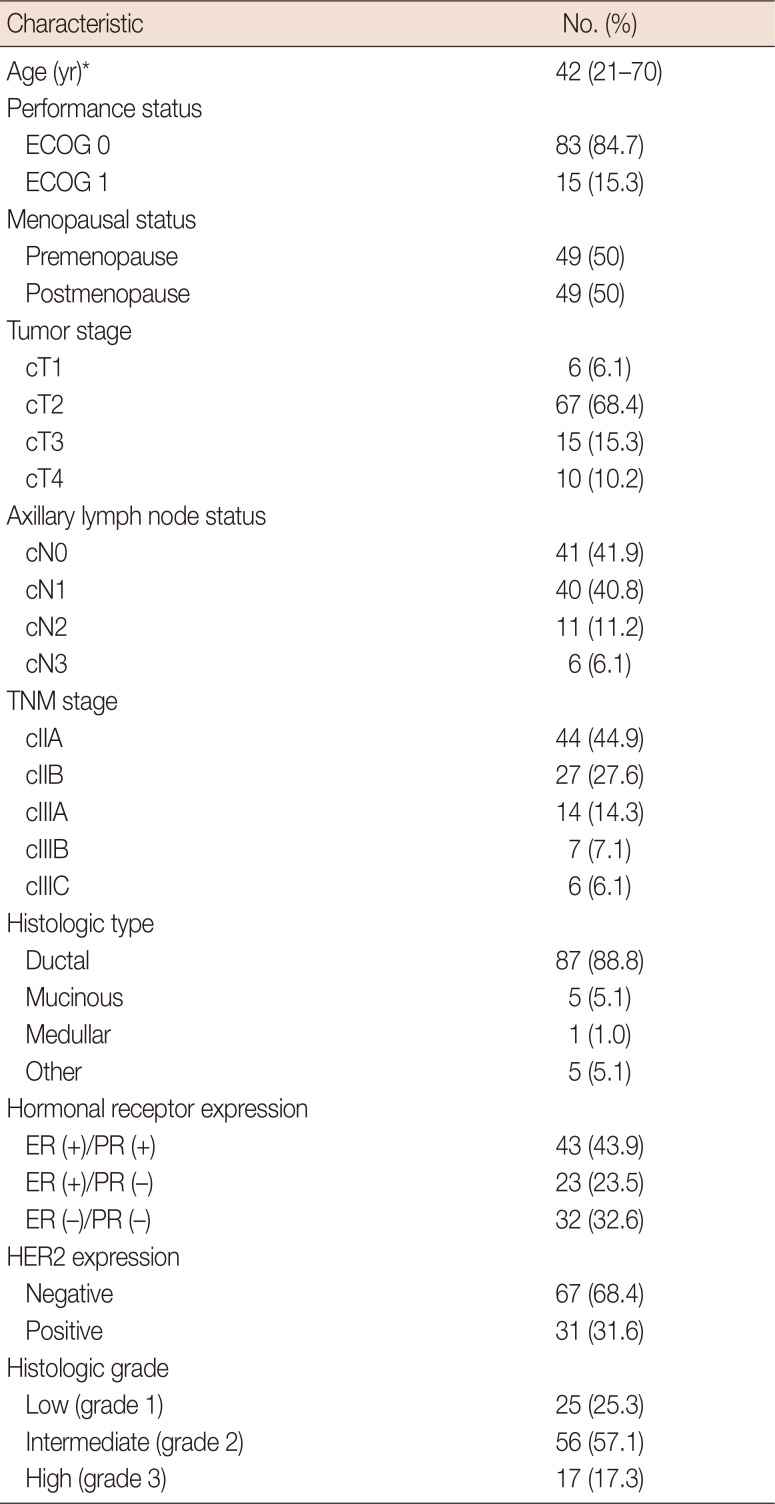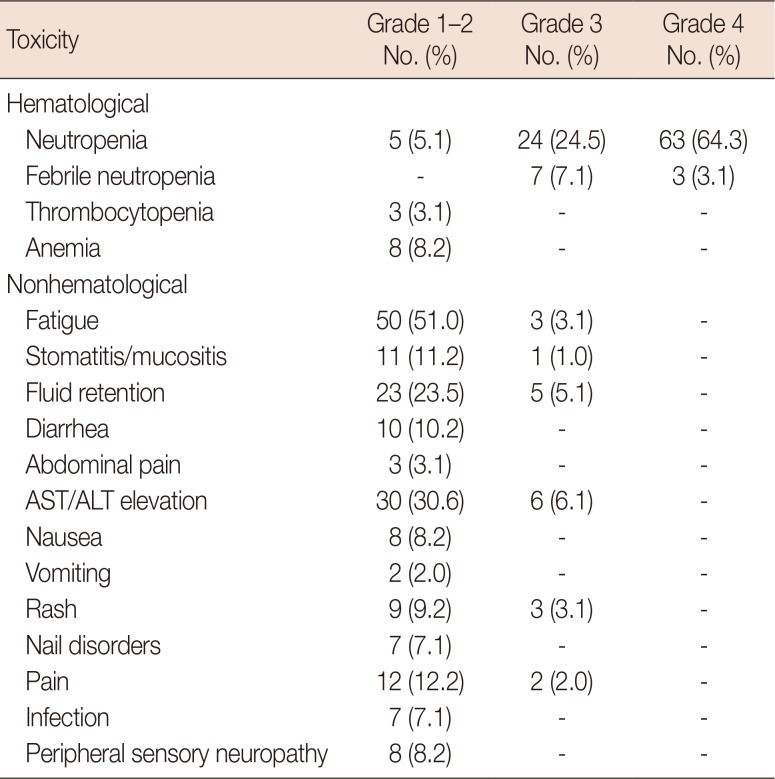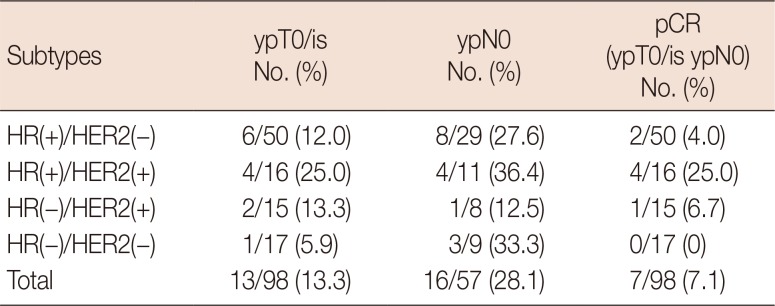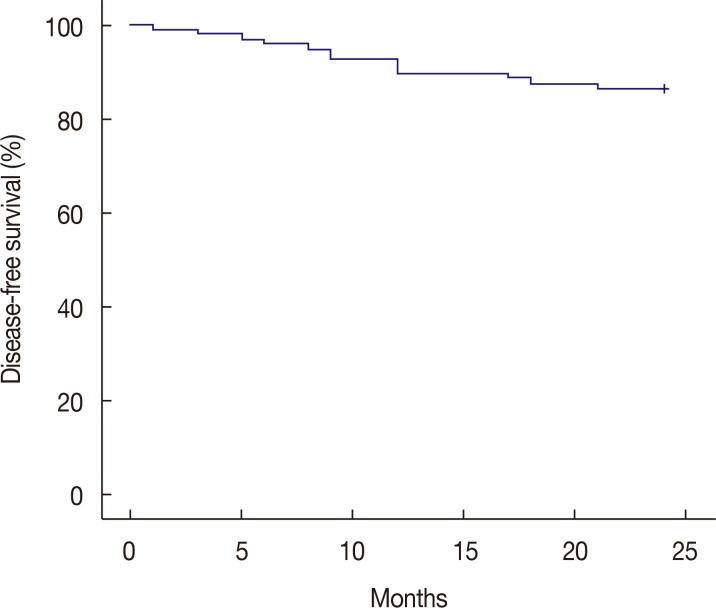1. Kaufmann M, Hortobagyi GN, Goldhirsch A, Scholl S, Makris A, Valagussa P, et al. Recommendations from an international expert panel on the use of neoadjuvant (primary) systemic treatment of operable breast cancer: an update. J Clin Oncol. 2006; 24:1940–1949. PMID:
16622270.

2. von Minckwitz G, Untch M, Blohmer JU, Costa SD, Eidtmann H, Fasching PA, et al. Definition and impact of pathologic complete response on prognosis after neoadjuvant chemotherapy in various intrinsic breast cancer subtypes. J Clin Oncol. 2012; 30:1796–1804. PMID:
22508812.

3. van der Hage JA, van de Velde CJ, Julien JP, Tubiana-Hulin M, Vandervelden C, Duchateau L. Preoperative chemotherapy in primary operable breast cancer: results from the European Organization for Research and Treatment of Cancer trial 10902. J Clin Oncol. 2001; 19:4224–4237. PMID:
11709566.

4. Vriens BE, Aarts MJ, de Vries B, van Gastel SM, Wals J, Smilde TJ, et al. Doxorubicin/cyclophosphamide with concurrent versus sequential docetaxel as neoadjuvant treatment in patients with breast cancer. Eur J Cancer. 2013; 49:3102–3110. PMID:
23850450.

5. Kuerer HM, Newman LA, Smith TL, Ames FC, Hunt KK, Dhingra K, et al. Clinical course of breast cancer patients with complete pathologic primary tumor and axillary lymph node response to doxorubicin-based neoadjuvant chemotherapy. J Clin Oncol. 1999; 17:460–469. PMID:
10080586.

6. Mavroudis D, Malamos N, Alexopoulos A, Kourousis C, Agelaki S, Sarra E, et al. Salvage chemotherapy in anthracycline-pretreated metastatic breast cancer patients with docetaxel and gemcitabine: a multicenter phase II trial. Ann Oncol. 1999; 10:211–215. PMID:
10093691.

7. O'Shaughnessy J, Miles D, Vukelja S, Moiseyenko V, Ayoub JP, Cervantes G, et al. Superior survival with capecitabine plus docetaxel combination therapy in anthracycline-pretreated patients with advanced breast cancer: phase III trial results. J Clin Oncol. 2002; 20:2812–2823. PMID:
12065558.
8. Kelly CM, Green MC, Broglio K, Thomas ES, Brewster AM, Valero V, et al. Phase III trial evaluating weekly paclitaxel versus docetaxel in combination with capecitabine in operable breast cancer. J Clin Oncol. 2012; 30:930–935. PMID:
22331946.

9. Del Mastro L, Fabi A, Mansutti M, De Laurentiis M, Durando A, Colantuoni G, et al. Phase III trial of first-line treatment with gemcitabine plus docetaxel versus gemcitabine plus paclitaxel in women with metastatic breast cancer (MBC): a comparison of different schedules and treatment. In : 2012 ASCO Annual Meeting; 2012. p. 30. Abstract #1073.
10. Tomova A, Bartsch R, Brodowicz T, Tzekova V, Timcheva C, Wiltschke C, et al. Concomitant docetaxel plus gemcitabine versus sequential docetaxel followed by gemcitabine in anthracycline-pretreated metastatic or locally recurrent inoperable breast cancer patients: a prospective multicentre trial of the Central European Cooperative Oncology Group (CECOG). Breast Cancer Res Treat. 2010; 119:169–176. PMID:
19768533.

11. Heinemann V. Role of gemcitabine in the treatment of advanced and metastatic breast cancer. Oncology. 2003; 64:191–206. PMID:
12697958.

12. Joensuu H, Sailas L, Alanko T, Sunela K, Huuhtanen R, Utriainen M, et al. Docetaxel versus docetaxel alternating with gemcitabine as treatments of advanced breast cancer: final analysis of a randomised trial. Ann Oncol. 2010; 21:968–973. PMID:
19819914.

13. Estévez LG, Sánchez-Rovira P, Dómine M, León A, Calvo I, Jaén A, et al. Biweekly docetaxel and gemcitabine as neoadjuvant chemotherapy followed by adjuvant doxorubicin and cyclophosphamide therapy in stage II and III breast cancer patients: results of a phase II study. Clin Transl Oncol. 2007; 9:317–322. PMID:
17525042.

14. Yardley DA. Gemcitabine and docetaxel in metastatic and neoadjuvant treatment of breast cancer. Semin Oncol. 2004; 31(2 Suppl 5):37–44.

15. Diéras V, Fumoleau P, Romieu G, Tubiana-Hulin M, Namer M, Mauriac L, et al. Randomized parallel study of doxorubicin plus paclitaxel and doxorubicin plus cyclophosphamide as neoadjuvant treatment of patients with breast cancer. J Clin Oncol. 2004; 22:4958–4965. PMID:
15611510.

16. Buzdar AU. Preoperative chemotherapy treatment of breast cancer: a review. Cancer. 2007; 110:2394–2407. PMID:
17941030.
17. Smorenburg CH, Bontenbal M, Seynaeve C, van Zuylen C, de Heus G, Verweij J, et al. Phase II study of weekly gemcitabine in patients with metastatic breast cancer relapsing or failing both an anthracycline and a taxane. Breast Cancer Res Treat. 2001; 66:83–87. PMID:
11368414.

18. Rha SY, Moon YH, Jeung HC, Kim YT, Sohn JH, Yang WI, et al. Gemcitabine monotherapy as salvage chemotherapy in heavily pretreated metastatic breast cancer. Breast Cancer Res Treat. 2005; 90:215–221. PMID:
15830134.

19. Modi S, Currie VE, Seidman AD, Bach AM, Panageas KS, Theodoulou M, et al. A phase II trial of gemcitabine in patients with metastatic breast cancer previously treated with an anthracycline and taxane. Clin Breast Cancer. 2005; 6:55–60. PMID:
15899073.

20. Metro G, Fabi A, Russillo M, Papaldo P, De Laurentiis M, Ferretti G, et al. Taxanes and gemcitabine doublets in the management of HER-2 negative metastatic breast cancer: towards optimization of association and schedule. Anticancer Res. 2008; 28:1245–1258. PMID:
18505062.
21. Yang Y, Im SA, Keam B, Lee KH, Kim TY, Suh KJ, et al. Prognostic impact of AJCC response criteria for neoadjuvant chemotherapy in stage II/III breast cancer patients: breast cancer subtype analyses. BMC Cancer. 2016; 16:515. PMID:
27444430.

22. McCarthy N, Boyle F, Zdenkowski N, Bull J, Leong E, Simpson A, et al. Neoadjuvant chemotherapy with sequential anthracycline-docetaxel with gemcitabine for large operable or locally advanced breast cancer: ANZ 0502 (NeoGem). Breast. 2014; 23:142–151. PMID:
24393617.

23. von Minckwitz G, Kümmel S, du Bois A, Eiermann W, Eidtmann H, Gerber B, et al. Pegfilgrastim +/- ciprofloxacin for primary prophylaxis with TAC (docetaxel/doxorubicin/cyclophosphamide) chemotherapy for breast cancer: results from the GEPARTRIO study. Ann Oncol. 2008; 19:292–298. PMID:
17846019.

24. Von Minckwitz G, Loibl S, Untch M. What is the current standard of care for anti-HER2 neoadjuvant therapy in breast cancer? Oncology (Williston Park). 2012; 26:20–26. PMID:
22393792.
25. Wuerstlein R, Harbeck N. Neoadjuvant therapy for HER2-positive breast cancer. Rev Recent Clin Trials. 2017; 12:81–92. PMID:
28164759.








 PDF
PDF ePub
ePub Citation
Citation Print
Print



 XML Download
XML Download